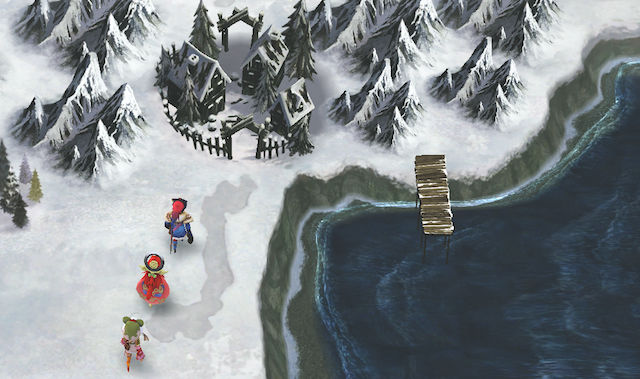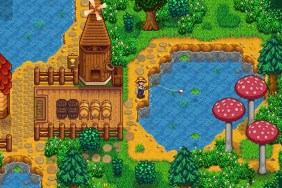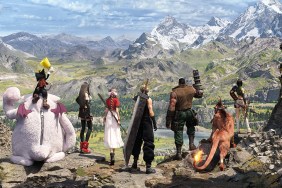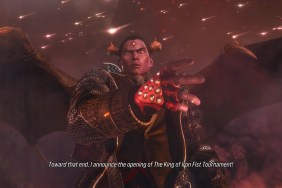The snow’s so pretty in July.
On a day in the snow-blanketed wilderness, you (and by that I mean your protagonist of course) are sent on a quest to save a small child who wandered away from his or her guardians. Ambushed by a pack of wild beasts, they were in no way capable of defending themselves, so you take the mission, easily slaying the threat with a few strikes. The child saved, you get paid for the job, and you are just as quickly hired for a another mission: to slay the sacrifice, the one required to quell the rise of monsters for the next ten years.
The sacrifice’s name… is Setsuna. Kinda shitty for her, right?
This is the start to the classically-styled JRPG I Am Setsuna, where the experience begins with a moral conundrum that you’ll spend the rest of the game mulling over in your head. That’s not the only moral question you’ll be asked to rationalize or fight head-on. Whether lying to protect a village is worth potentially losing the fight for the rest of the world, whether putting your long-term mission above the more immediate saving of lives in the short-term, whether you plan to do the job or not, and even whether to hold your peace when confronted with the one that hired you for the job are all a part of the game's central conflict. The motto of the writers seems to have been “let’s bend the moral compass at every turn town.”
And damn it can get depressing. Without giving too much plot away, the story of Setsuna’s race to the Last Lands to save the world from being overrun with monsters is filled with dispiriting detours—elders who need protection, crazy knights, sad backstories, lost loves. Every character seems to carry a powerful regret or question with them, and while some can overcome it and be happy, others will be weeping messes while they’re not in battle. The writing is better than the translations were back in the SNES days (thank our lucky stars) but the interwoven story between these characters feels more natural than most RPGs of the style. Sure, they’re not all friends; they bicker and discover one another along the journey by happenstance, but it doesn’t feel forced.
I Am Setsuna is a sort of the “best hits” of the Square Enix lineage: a fighting system modeled by Chrono Trigger, a “spritnite” spell system reminiscent of Final Fantasy VII's, wrapped in a visual style that takes the look of the best SNES and PSOne RPGs and brings the paintings that were once the backdrops to life. For older fans of that era and that genre, this feels more like playing a brand new game after school or in a college dorm than firing up an old classic. It feels like a small team’s pet project, built like a gaming Frankenstein’s monster of memories and sensations of finding FFIV for the first time.
First, the battle system is traditional. For the totally uninitiated, up to three characters can fight a given battle, each having to wait for their meter to fill up before they can attack and select from a roster of techniques. From there it’s a standard menu-based selection. Some attacks will break your formation, which can cause a character to be isolated, but certain attacks can move or even gather either enemies or allies together. With many elemental attacks including surrounding damage, this can put the hurt on an enemy group without breaking the bank buying ethers.
Developing characters involves the system of “spritnite” that work like materia in FFVII. Slipping discovered materials to the traveling member of the magic consortium allows for trading those materials for their associated spritnites. And it’s those spritnite that determine what boosts, buffs, protection, or available techniques your characters have access to. It was a brilliant RPG mechanic in 1997, and it still does the job well here. They can be swapped around to any of your allies (provided that they have the ability to use them), and from how much loot you take along your travels, you’ll have plenty to trade around.
This isn’t something I normally would notice while I’m playing through a game, but it’s very clear where the entrances and exits are on a map by the enemies contained. Clearly marked by their difficulty in both how many enemies and how strong those enemies are in a location, navigating through the largely uncomplicated locales is remarkably easy. It not only gives an accurate and approachable way to enter a new space, but trains a player and levels their characters fast enough to provide both a challenge and that feeling of accomplishment. The boss battles are sort of that way as well; it usually only took me two attempts to work through a boss after consistent leveling. I didn’t get through by the skin of my teeth, but I wasn’t exactly in healthy shape for another go-round either. Accomplishment!
Back in the PSOne days, the best-looking games from the Square label had something in common: They used a pre-rendered backdrop, then allowed the sprites to walk over the top à la FFVII and Parasite Eve. The end result was a pixelated block to represent your character (looking back now, those sprites were just sad really) on top of a photorealistic world, with just enough glossy finish to remind you it wasn’t the real deal. In Setsuna the locations are just as wonderful, though more obviously giving the impression of a painting of a snow-covered land. The snow makes way for the party rushing past it and refills the party's tracks if you come by again later. The characters moving on top matches more with the backgrounds, so it’s not nearly as jarring a visual contrast. It’s odd to say it this way, but this looks like a classic JRPG's dream come to life.
And the music, thank any and every god, the music. Almost every single track sounds like a perfect loop of a single composer playing a single piano, the only exceptions being battle tracks with have a bit of beat to them. Otherwise, there's no complicated accompaniment, no out-of-nowhere electric guitars or cowbells, just clear keys ringing out of the TV. Every song—and I can’t stress this enough—is perfect for the setting it inhabits, from the overworld to caves to battle. Every single track flows into one another with barely a notice that a transition happened at all. I want this soundtrack by itself in my playlists; hell, I want this soundtrack backing my life. It’s almost as if Square Enix has had a history of producing wonderful game setting music or something…
I Am Setsuna isn't without its drawbacks, though and there are a few. As this is such a love letter to the RPGs of older generations, there aren’t many new ideas throughout the design, even if the ideas it does take fit together like puzzle pieces. And while it’s a modern JRPG with that classic take, it does fit the appearance in the same way a pin-up from the 1940s is still pretty but obviously a product of its time. That’s not even really a negative, but I can see the older-style presentation turning off some players. And to those players, I say it’s a damn shame.
The game also doesn’t require as much grinding as other JRPGs, which is a coin flip for a positive or negative point. I usually like a little grinding should the battle system be rewarding enough, and it’s better than normal here, but not the driving factor behind how much I appreciate it. So it’s disappointing that way, but it allows for fewer interruptions in storytelling, which is worth the tradeoff I’d say.
As far as old-style RPGs go, I Am Setsuna was worth looking forward to after the showing at E3 this year, and just as worth playing. All of the little elements to the nostalgia part of my brain have been tickled, and at parts of the story I was nearly ready to shed a tear or two. I don’t know how much this will appeal to younger gamers grown up on more sophisticated role-playing titles, JRPG or otherwise, but for anyone who can appreciate the legends Square (not Square Enix as much) put out generations ago, this won’t just scratch your back—it will tuck you into bed, safe and sound, just like the end of a good story should be.
-
Old-school presentation, new-school visuals
-
Engaging story that pulls at the heartstrings
-
Music may be my favorite new soundtrack to a game
-
Ease of entry for classic JRPG players
-
Battle system is both easy and deep
-
...but not innovative in any way
-
Very retro feel
-
Repetitive loading times when entering new locales
-
Not a joke plus, I just really love this soundtrack. So, SO much.
I Am Setsuna preview images
-
I Am Setsuna preview images #1
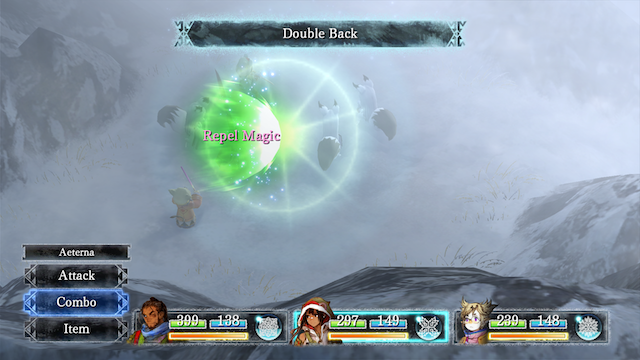
-
I Am Setsuna preview images #2
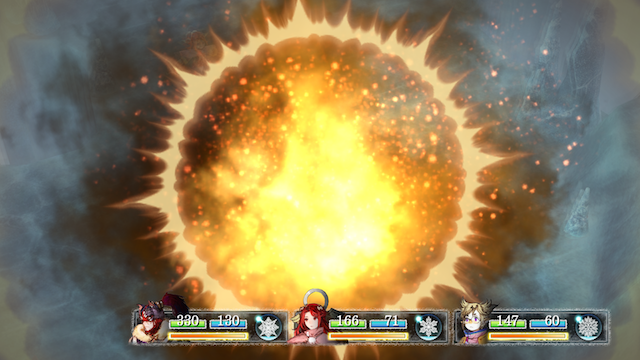
-
I Am Setsuna preview images #3
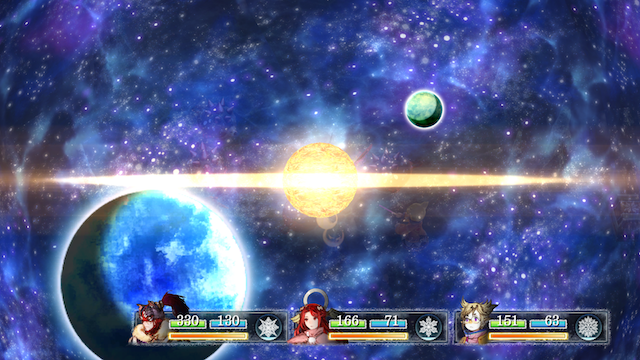
-
I Am Setsuna preview images #4
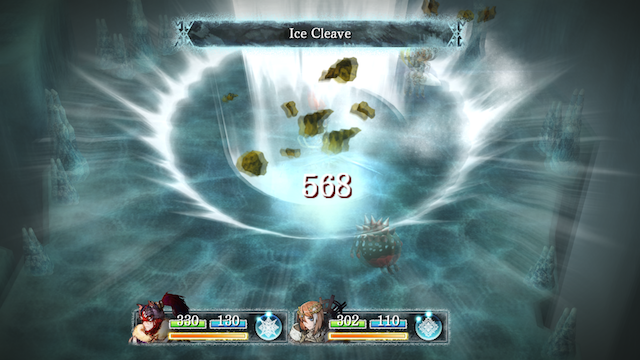
-
I Am Setsuna preview images #5
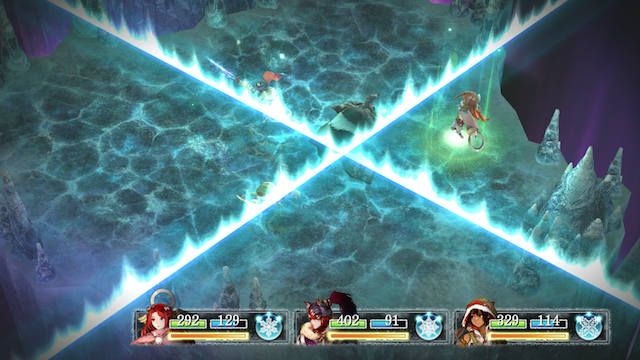
-
I Am Setsuna preview images #6
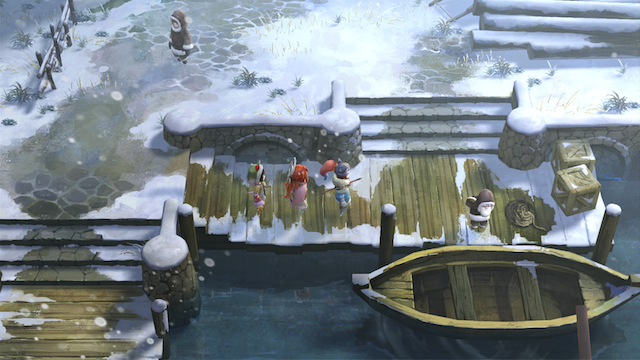
-
I Am Setsuna preview images #7
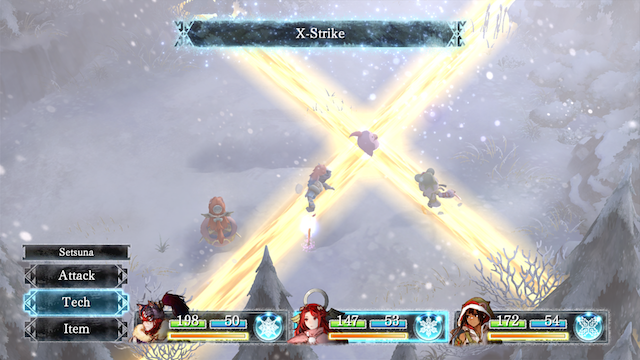
-
I Am Setsuna preview images #8
